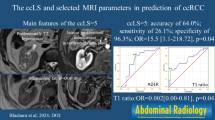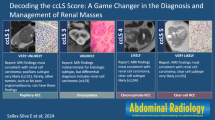Abstract
Objective
To evaluate a recently proposed CT-based algorithm for diagnosis of clear-cell renal cell carcinoma (ccRCC) among small (≤ 4 cm) solid renal masses diagnosed by renal mass biopsy.
Methods
This retrospective study included 51 small renal masses in 51 patients with renal-mass CT and biopsy between 2014 and 2021. Three radiologists independently evaluated corticomedullary phase CT for the following: heterogeneity and attenuation ratio (mass:renal cortex), which were used to inform the CT score (1–5). CT score ≥ 4 was considered positive for ccRCC. Diagnostic accuracy was calculated for each reader and overall using fixed effects logistic regression modelling.
Results
There were 51% (26/51) ccRCC and 49% (25/51) other masses. For diagnosis of ccRCC, area under curve (AUC), sensitivity, specificity, and positive predictive value (PPV) were 0.69 (95% confidence interval 0.61–0.76), 78% (68–86%), 59% (46–71%), and 67% (54–79%), respectively. CT score ≤ 2 had a negative predictive value 97% (92–99%) to exclude diagnosis of ccRCC. For diagnosis of papillary renal cell carcinoma (pRCC), CT score ≤ 2, AUC, sensitivity, specificity, and PPV were 0.89 (0.81–0.98), 81% (58–94%), 98% (93–99%), and 85% (62–97%), respectively. Pooled inter-observer agreement for CT scoring was moderate (Fleiss weighted kappa = 0.52).
Conclusion
The CT scoring system for prediction of ccRCC was sensitive with a high negative predictive value and moderate agreement. The CT score is highly specific for diagnosis of pRCC.
Clinical relevance statement
The CT score algorithm may help guide renal mass biopsy decisions in clinical practice, with high sensitivity to identify clear-cell tumors for biopsy to establish diagnosis and grade and high specificity to avoid biopsy in papillary tumors.
Key Points
• A CT score ≥ 4 had high sensitivity and negative predictive value for diagnosis of clear-cell renal cell carcinoma (RCC) among solid ≤ 4-cm renal masses.
• A CT score ≤ 2 was highly specific for diagnosis of papillary RCC among solid ≤ 4-cm renal masses.
• Inter-observer agreement for CT score was moderate.



Similar content being viewed by others
Abbreviations
- AS :
-
Active surveillance
- ccLS :
-
Clear-cell likelihood score
- ccRCC:
-
Clear-cell renal cell carcinoma
- CIs:
-
Confidence intervals
- ISUP:
-
International Society of Urogenital Pathology
- MDCT:
-
Multi-detector computed tomography
- Mp:
-
Multi-parametric
- MRI:
-
Magnetic resonance imaging
- NPV:
-
Negative predictive value
- PPV:
-
Positive predictive value
- pRCC:
-
Papillary renal cell carcinoma
- SD:
-
Standard deviation
- SEI:
-
Segmental enhancement inversion
References
Meyer HJ, Pfeil A, Schramm D, Bach AG, Surov A (2017) Renal incidental findings on computed tomography: frequency and distribution in a large non selected cohort. Medicine (Baltimore) 96:e7039
O’Connor SD, Pickhardt PJ, Kim DH, Oliva MR, Silverman SG (2011) Incidental finding of renal masses at unenhanced CT: prevalence and analysis of features for guiding management. AJR Am J Roentgenol 197:139–145
Silverman SG, Pedrosa I, Ellis JH et al (2019) Bosniak classification of cystic renal masses, version 2019: an update proposal and needs assessment. Radiology. https://doi.org/10.1148/radiol.2019182646:182646
Remzi M, Ozsoy M, Klingler HC et al (2006) Are small renal tumors harmless? Analysis of histopathological features according to tumors 4 cm or less in diameter. J Urol 176:896–899
Pahernik S, Ziegler S, Roos F, Melchior SW, Thuroff JW (2007) Small renal tumors: correlation of clinical and pathological features with tumor size. J Urol 178:414–417; discussion 416–417
Finelli A, Cheung DC, Al-Matar A et al (2020) Small renal mass surveillance: histology-specific growth rates in a biopsy-characterized cohort. Eur Urol 78:460–467
Schieda N, Krishna S, Pedrosa I, Kaffenberger SD, Davenport MS, Silverman SG (2021) Active surveillance of renal masses: the role of radiology. Radiology. https://doi.org/10.1148/radiol.2021204227:204227
Patel DN, Ghali F, Meagher MF et al (2021) Utilization of renal mass biopsy in patients with localized renal cell carcinoma: a population-based study utilizing the National Cancer Database. Urol Oncol 39:79 e71–79 e78
Marconi L, Dabestani S, Lam TB et al (2016) Systematic review and meta-analysis of diagnostic accuracy of percutaneous renal tumour biopsy. Eur Urol 69:660–673
Lim CS, Schieda N, Silverman SG (2019) Update on indications for percutaneous renal mass biopsy in the era of advanced CT and MRI. AJR Am J Roentgenol. https://doi.org/10.2214/AJR.19.21093:1-10
Kay FU, Canvasser NE, ** Y et al (2018) Diagnostic performance and interreader agreement of a standardized MR imaging approach in the prediction of small renal mass histology. Radiology 287:543–553
Canvasser NE, Kay FU, ** Y et al (2017) Diagnostic accuracy of multiparametric magnetic resonance imaging to identify clear cell renal cell carcinoma in cT1a renal masses. J Urol 198:780–786
Johnson BA, Kim S, Steinberg RL, de Leon AD, Pedrosa I, Cadeddu JA (2019) Diagnostic performance of prospectively assigned clear cell likelihood scores (ccLS) in small renal masses at multiparametric magnetic resonance imaging. Urol Oncol 37:941–946
Schieda N, Davenport MS, Silverman SG et al (2022) Multicenter evaluation of multiparametric MRI clear cell likelihood scores in solid indeterminate small renal masses. Radiology. https://doi.org/10.1148/radiol.211680:211680
Baldari D, Capece S, Mainenti PP et al (2015) Comparison between computed tomography multislice and high-field magnetic resonance in the diagnostic evaluation of patients with renal masses. Quant Imaging Med Surg 5:691–699
Al Nasibi K, Pickovsky JS, Eldehimi F et al (2022) Development of a multiparametric renal CT algorithm for diagnosis of clear-cell renal cell carcinoma among small (</=4 cm) solid renal masses. AJR Am J Roentgenol. https://doi.org/10.2214/AJR.22.27971
Lemieux S, Shen L, Liang T et al (2023) External validation of a five-tiered CT algorithm for the diagnosis of clear-cell renal cell carcinoma: a retrospective five-reader study. AJR Am J Roentgenol. https://doi.org/10.2214/AJR.23.29151
Kang SK, Huang WC, Pandharipande PV, Chandarana H (2014) Solid renal masses: what the numbers tell us. AJR Am J Roentgenol 202:1196–1206
Moch H, Cubilla AL, Humphrey PA, Reuter VE, Ulbright TM (2016) The 2016 WHO classification of tumours of the urinary system and male genital organs-part A: renal, penile, and testicular tumours. Eur Urol 70:93–105
Nguyen K, Schieda N, James N, McInnes MDF, Wu M, Thornhill RE (2021) Effect of phase of enhancement on texture analysis in renal masses evaluated with non-contrast-enhanced, corticomedullary, and nephrographic phase-enhanced CT images. Eur Radiol 31(3):1676–1686. https://doi.org/10.1007/s00330-020-07233-6
Pedrosa I, Cadeddu JA (2022) How we do it: managing the indeterminate renal mass with the MRI clear cell likelihood score. Radiology 302:256–269
Kim JI, Cho JY, Moon KC, Lee HJ, Kim SH (2009) Segmental enhancement inversion at biphasic multidetector CT: characteristic finding of small renal oncocytoma. Radiology 252:441–448
Eldehimi F, Pickovsky JS, Al Nasibi K, Schieda N (2023) Proposed modifications to the multiparametric CT score for diagnosis of ccRCC using hyperattenuation, segmental enhancement inversion, and ADER: a secondary analysis. AJR Am J Roentgenol 221:144–146
Al Nasibi K, Pickovsky JS, Eldehimi F et al (2022) Development of a multiparametric renal CT algorithm for diagnosis of clear cell renal cell carcinoma among small (</= 4 cm) solid renal masses. AJR Am J Roentgenol. https://doi.org/10.2214/AJR.22.27971:1-10
Steinberg RL, Rasmussen RG, Johnson BA et al (2020) Prospective performance of clear cell likelihood scores (ccLS) in renal masses evaluated with multiparametric magnetic resonance imaging. Eur Radiol. https://doi.org/10.1007/s00330-020-07093-0
Alaghehbandan R, Siadat F, Trpkov K (2022) What’s new in the WHO 2022 classification of kidney tumours? Pathologica 115:8–22
Funding
The authors state that this work has not received any funding.
Author information
Authors and Affiliations
Corresponding author
Ethics declarations
Guarantor
The scientific guarantor of this publication is Dr Nicola Schieda.
Conflict of interest
The authors of this manuscript declare no relationships with any companies, whose products or services may be related to the subject matter of the article.
Statistics and biometry
Statistical analysis performed by Dr. Nicola Schieda.
Informed consent
Written informed consent was waived by the Institutional Review Board.
Ethical approval
Institutional Review Board (Ottawa Hospital Research Ethics Board) approval was obtained.
Study subjects or cohorts overlap
None.
Methodology
• retrospective
• cross-sectional study
• performed at one institution
Additional information
Publisher's Note
Springer Nature remains neutral with regard to jurisdictional claims in published maps and institutional affiliations.
Supplementary Information
Below is the link to the electronic supplementary material.
Rights and permissions
Springer Nature or its licensor (e.g. a society or other partner) holds exclusive rights to this article under a publishing agreement with the author(s) or other rightsholder(s); author self-archiving of the accepted manuscript version of this article is solely governed by the terms of such publishing agreement and applicable law.
About this article
Cite this article
Eldihimi, F., Walsh, C., Hibbert, R.M. et al. Evaluation of a multiparametric renal CT algorithm for diagnosis of clear-cell renal cell carcinoma among small (≤ 4 cm) solid renal masses. Eur Radiol 34, 3992–4000 (2024). https://doi.org/10.1007/s00330-023-10434-4
Received:
Revised:
Accepted:
Published:
Issue Date:
DOI: https://doi.org/10.1007/s00330-023-10434-4




